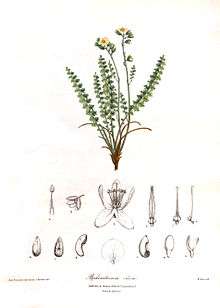Biebersteinia
Biebersteinia is a genus containing five species,[2] of herbs in the flowering plant order Sapindales. They occur from East Mediterranean to West Siberia and Central Asia.[3] They are normally stemless and have tuberous rhizomes.[4]
| Biebersteinia | |
|---|---|
 | |
| Biebersteinia odora | |
| Scientific classification | |
| Kingdom: | Plantae |
| Clade: | Tracheophytes |
| Clade: | Angiosperms |
| Clade: | Eudicots |
| Clade: | Rosids |
| Order: | Sapindales |
| Family: | Biebersteiniaceae Schnizl.[1] |
| Genus: | Biebersteinia Stephan |
| Species | |
|
Biebersteinia emodii | |
In 1806, Christian Friedrich Stephan formed the genus Biebersteinia, then in 1841 Endlicher converted it to a family status. This was the start of various changes to the genus. It was then placed in Geraniaceae by Pierre Edmond Boissier,[5] in 1867, and changed by various botanists (including Knuth (1912), Thorne (1992), Cronquist (1981, 1988), Dahlgren (1989) and Takhtajan (1987 and 1997)).[6]
In 2007, molecular phylogenetic studies have given it a basal position within Sapindales.[7] In the APG III system and in the Kubitzki system, it is placed in its own monogeneric family, Biebersteiniaceae, one of the few herbaceous members of Sapindales (the others being found in Rutaceae).
The name refers to a German botanist Friedrich August Marschall von Bieberstein (1768–1826).
In 2001, five types of flavonoids have been derived from extracts from Biebersteinia orphanidis leaves.[5]
Species
- Biebersteinia emodii Jaub. & Spach
- Biebersteinia heterostemon Maxim.
- Biebersteinia multifida DC.
- Biebersteinia odora Stephan ex Fisch.
- Biebersteinia orphanidis Boiss.
References
- Angiosperm Phylogeny Group (2009). "An update of the Angiosperm Phylogeny Group classification for the orders and families of flowering plants: APG III". Botanical Journal of the Linnean Society. 161 (2): 105–121. doi:10.1111/j.1095-8339.2009.00996.x.
- Christenhusz, M. J. M. & Byng, J. W. (2016). "The number of known plants species in the world and its annual increase". Phytotaxa. 261 (3): 201–217. doi:10.11646/phytotaxa.261.3.1.
- A. N. Muellner: "Biebersteiniaceae" in Klaus Kubitzki (Volume Editor) (2011). The Families and Genera of Vascular Plants Vol. X: Flowering Plants Eudicots. Springer Verlag Berlin. p. 72. ISBN 978-3-642-14396-0.
- Armen Takhtajan Flowering Plants, p. 367, at Google Books
- Greenham, J.; Vassiliades, D.D.; Harborne, J.B.; Williams, C.A.; Eagles, J.; Grayer, R.J.; Veitch, N.C. (January 2001). "A distinctive flavonoid chemistry for the anomalous genus Biebersteinia". Phytochemistry. 56 (1): 87–91. doi:10.1016/s0031-9422(00)00355-1. PMID 11198823.
- Jianquan, Liu; Tingnong, Ho; Shilong, Chen; Anmin, Lu (2001). "Karyomorphology of Biebersteinia Stephan (Geraniaceae) and its systematic and taxonomic significance". Bot. Bull. Acad. Sin. 42: 61–66. Retrieved 10 August 2017.
- Muellner, Vassiliades & Renner 2007
External links
- Muellner, Alexandra N.; Vassiliades, Dionyssios D.; Renner, Susanne S. (2007). "Placing Biebersteiniaceae, a herbaceous clade of Sapindales, in a temporal and geographic context". Plant Systematics and Evolution. 266 (3–4): 233–252. CiteSeerX 10.1.1.331.573. doi:10.1007/s00606-007-0546-x.CS1 maint: ref=harv (link)
- Biebersteiniaceae of Mongolia in FloraGREIF